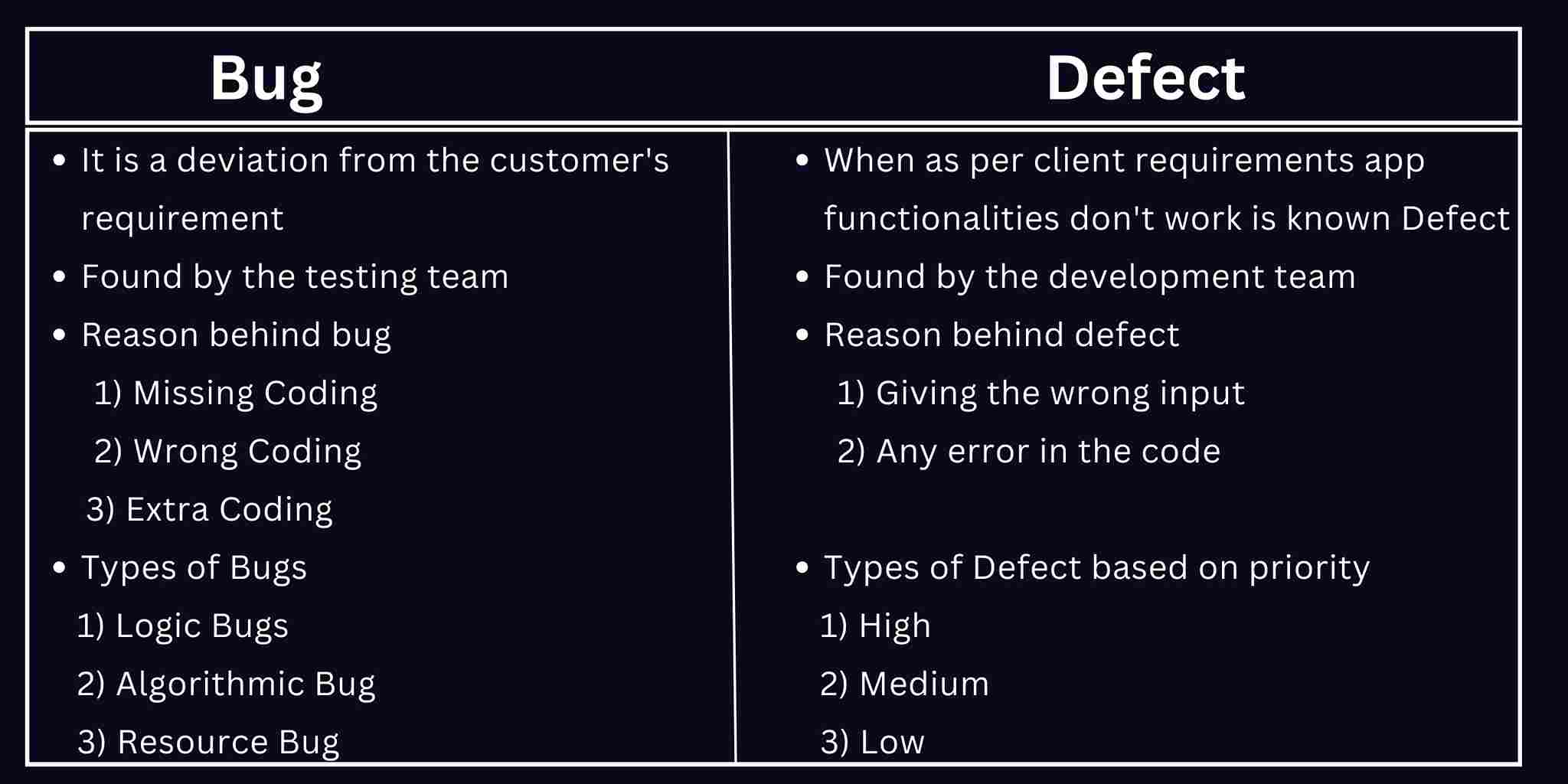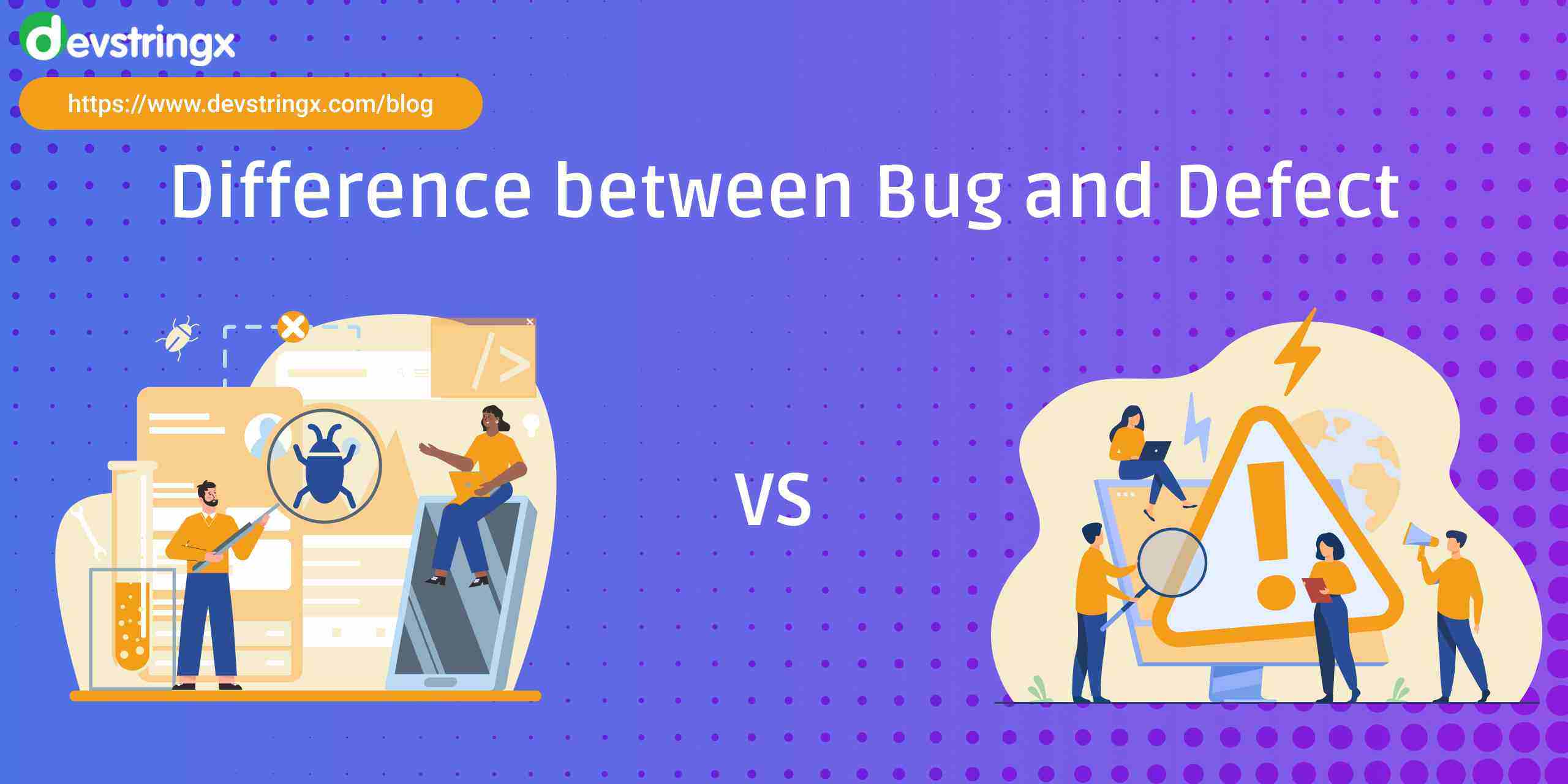Difference Between Bug and Defect With Examples | Defect Vs Bug – Devstringx
Bug Vs Defect
Oftentimes, people use the terms “bugs” and “defects” interchangeably in the software development world. However, there is actually a subtle difference between the two.
A bug is an error in the code that causes unexpected behavior. On the other hand, a defect is an incorrect requirement or design that causes incorrect behavior.
In other words, a fault should have been caught during the requirements gathering or design phase, while a bug was missed during the coding phase.
What Is Bug?
While software testing, testers are responsible for finding any discrepancies between the customer’s expectations and what is actually delivered. Commonly known as bugs, these deviations can be subtle or glaring but must ultimately identify to create a quality product.
What Is a Defect?
A defect is an issue found during the development process of a program or application, usually resulting from incorrect user input that disrupts expected functionality. Unit testing can help to prevent these issues by monitoring for errors in code and unexpected behavior when given particular inputs.
How to Find and Fix Bugs?
Uncovering bugs can be the key to success when developing software. From detecting potential flaws during development through a rigorous STLC process, or asking customers for feedback after release – testing is integral in finding and resolving any issues relating to your product.
Keeping an ear to the ground for customer feedback can be a great way of spotting pesky bugs before they become too widespread. Through channels such as customer support, social media, and online reviews, you can easily stay on top of any issues that may have slipped through your testing process.
When a fault is discovered in software, technicians patch the program to repair it. Patches are often available as updates for customers so they can keep their programs functioning effectively. However, behind-the-scenes fixes may be made too – ensuring that bugs won’t cause any more disruptions!
Recommended to Read- Smoke Testing Vs Sanity Testing
How to Report a Bug or Defect?
Reporting a bug or defect can feel like a daunting task, especially if you’re not tech-savvy. However, the feeling of accomplishment when it gets fixed is unmatchable!
All joking aside, reporting a bug or defect should be taken seriously. As it could help improve products, services, or software and make them better for everyone to use.
Start by gathering as much information as possible about the system where the issue occurred. This includes what type of device you were using, its current software version, and how often this error occurs.
After gathering all the necessary information you’re ready to contact customer service and describe the problem in detail with screenshots or video recordings if you have them.
In Last, provide feedback on how this issue can solve in the future so that similar problems won’t happen again. With these simple steps you can significantly contribute to making better products — aren’t you glad we told you?
What Is the Difference Between Bugs and Defects?

While bugs and defects can seem one and the same, there are some essential distinctions that set them apart. Whether it be a software program or physical product, knowing how to spot – and solve – these issues is key to success.
Software bugs can be costly and pervasive – often lurking in the code unbeknownst to everyone until they strike! From coding errors and incorrect assumptions to unexpected changes in the environment, these clumsy critters of computer programming have a way of wreaking havoc on both developers who find them during testing and customers after release. In either case, software companies are left picking up the bill for such unwelcome visitors.
Defects can be like landmines in a product, lying dormant until they crop up unexpectedly. In many cases the cause of these hidden flaws is difficult to track down; poor design decisions, incorrect use assumptions, and environmental changes could all have been responsible for their emergence.
Unfortunately, customers may have no choice but to tolerate them or develop workarounds if defects arise that cannot easily rectify – turning something seemingly perfect into an imperfect reality!
Recommended to Read- Test Strategy Vs Test Plan
The Benefits of Reporting Bugs and Defects
If you’re a software developer, it’s easy to get caught up in the creative process and forget about all the little bugs and defects that can pop up during development. But ignoring those tiny annoyances can be a big mistake. There are definite advantages to tracking and reporting them as soon as they appear.
For starters, catching bugs early is essential for the longevity of your product.
Reports also act as a form of documentation for software engineers. Developers know what prior problems need to address or prevent in the next version.
Not only that but keeping track of bug reports will help keep morale high since everyone loves being able to fix an issue with minimal effort!
So no matter how small or insignificant you may think they are, never underestimate the importance of reporting any issues that come up – you’ll thank yourself later!
Recommended to Read:- Regression Testing Vs Retesting
Final Words
Bugs and defects can be the bane of any software developer’s existence. But with a rigorous STLC process, customer feedback, and consistent bug reporting, these issues can manage much more effectively!
By understanding how to find and fix bugs, as well as how to report them properly — your products will reach their full potential in no time.
So don’t let those pesky insects ruin your day; take action instead and you’ll soon see the results! It may not seem like much now but eventually; all those little steps will pay off. So go ahead – get out there and start tracking down some bugs! Who knows? You might even become an insect-catching master!
That’s it for now! Thanks for reading. We hope this guide helps you tackle the difference between bugs & defects in your software development process. Happy bug-hunting!
Get a Free Product Testing Consultation! Contact Us Today
Frequently Asked Questions
A bug is an unexpected or unintended behavior of a software program. An example of a bug could be a calculator program that gives incorrect results when certain operations are performed. Another example could be a website that crashes when too many users try to access it simultaneously.
The bug and defect life cycle refers to the stages that a bug or defect goes through during the software development process. The stages typically include identification, logging, prioritization, assignment, resolution, and verification.
The concept of a bug refers to an error or fault in a software program that causes it to behave in an unintended way. Bugs can arise due to mistakes made during the development process, environmental factors, or user actions.
The terms “bug” and “defect” are often used interchangeably, but they can have slightly different meanings in some contexts. Generally, a bug is a problem that affects the behavior of a software program, while a defect is a problem that affects the functionality or performance of a system.














